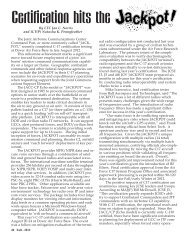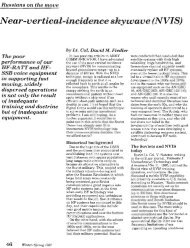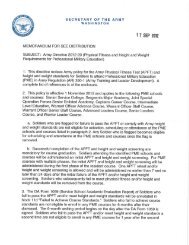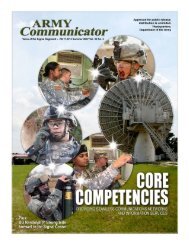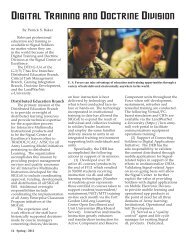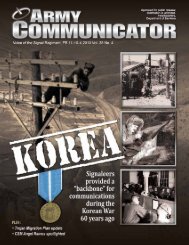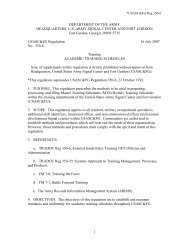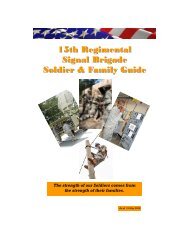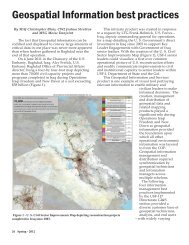AC Summer 08 WIN-T Online - United States Army Signal Center of ...
AC Summer 08 WIN-T Online - United States Army Signal Center of ...
AC Summer 08 WIN-T Online - United States Army Signal Center of ...
You also want an ePaper? Increase the reach of your titles
YUMPU automatically turns print PDFs into web optimized ePapers that Google loves.
PMO <strong>WIN</strong>-T<br />
By COL William C. “Chuck” Hoppe<br />
Introduction<br />
June 5, 2007, was a big day for<br />
the <strong>Army</strong>, the <strong>Army</strong> <strong>Signal</strong> Regiment,<br />
Program Executive Office<br />
Command, Control, and Communications<br />
Tactical and Project Manager<br />
Warfighter Information Network-<br />
Tactical. What was so special about<br />
June 5, 2007? That was the day the<br />
Under Secretary <strong>of</strong> Defense for<br />
Acquisition, Technology and Logistics,<br />
the Honorable Kenneth Krieg<br />
signed the Acquisition Decision<br />
Memorandum and [Nunn-<br />
McCurdy] Certification Package for<br />
the <strong>WIN</strong>-T program. The Nunn-<br />
McCurdy certification was the<br />
culminating point for two programs,<br />
the Joint Network Node-Network<br />
program and the <strong>WIN</strong>-T program. It<br />
was also the trigger in an event<br />
driven timeline for changes at Fort<br />
Monmouth, N.J., and some internal<br />
PEO C3T reorganization decisions.<br />
In this article, I will briefly describe<br />
the major impacts <strong>of</strong> the series <strong>of</strong><br />
events that came out <strong>of</strong> the Nunn-<br />
McCurdy certification <strong>of</strong> the <strong>WIN</strong>-T<br />
program; the reorganization <strong>of</strong><br />
certain programs within PEO C3T;<br />
and give a quick overview <strong>of</strong> the<br />
<strong>WIN</strong>-T Program Management<br />
Office; and finally, give an operational<br />
“so what?” as to the impact in<br />
the operational community.<br />
Nunn-McCurdy<br />
Through the calculus <strong>of</strong> Title<br />
10 <strong>United</strong> <strong>States</strong> Code Section 2433,<br />
Unit Cost Reporting, program<br />
managers <strong>of</strong> Major Defense Acquisition<br />
Programs like <strong>WIN</strong>-T have<br />
some pretty specific reporting<br />
requirements to the Congress.<br />
Fundamentally, Project Managers<br />
are always concerned with cost,<br />
schedule, and performance <strong>of</strong> their<br />
programs to ensure the required<br />
capability (performance) is provided<br />
in a timely manner (schedule) with<br />
the future is now!<br />
What was so special<br />
about June 5, 2007? ...<br />
The Nunn-McCurdy<br />
certification was the<br />
culminating point for<br />
two programs, the<br />
Joint Network Node-<br />
Network program and<br />
the <strong>WIN</strong>-T program.<br />
the best bang for the buck (cost) to<br />
support the warfighter while being<br />
good stewards <strong>of</strong> the taxpayers’<br />
dollar. For PMs <strong>of</strong> MDAPs, the<br />
Nunn-McCurdy requirements loom<br />
large and can have a significant<br />
impact on their programs if the<br />
tripwires are tripped. The Unit Cost<br />
Reporting section <strong>of</strong> Title 10 prescribes<br />
two specific criteria which<br />
require the PM to make special<br />
reports to Congress and in the case<br />
<strong>of</strong> the second criterion, prescribes<br />
that the department certify that<br />
program as necessary against some<br />
specified criteria or terminate it.<br />
The criteria are strictly metricsbased<br />
and when the thresholds are<br />
breached, the process is automatic<br />
regardless <strong>of</strong> why the program<br />
experienced the cost growth. PMs<br />
are required by this part <strong>of</strong> the law<br />
to report cost growths that meet 15<br />
percent growth (called significant<br />
cost growth) from the original<br />
baseline and 25 percent growth<br />
(called critical cost growth) from the<br />
original baseline. If a program<br />
experiences “critical cost growth,”<br />
Title 10 <strong>United</strong> <strong>States</strong> Code § 2433<br />
(e)(2)(b) requires a written certification<br />
<strong>of</strong> basically five things, the cost<br />
<strong>of</strong> the program and that the pro-<br />
gram is:<br />
1) essential to national security;<br />
2) there’s no alternative which<br />
will provide equal or greater<br />
military capability at less cost;<br />
3) the new estimated costs are<br />
reasonable; and<br />
4) the management structure<br />
is adequate.<br />
One <strong>of</strong> the outcomes <strong>of</strong> the<br />
June 5, 2007, ADM is that the<br />
USD(AT&L) certified the restructured<br />
<strong>WIN</strong>-T program in accordance<br />
with those criteria. There were two<br />
other outcomes <strong>of</strong> the Nunn-<br />
McCurdy process; as just stated, the<br />
<strong>WIN</strong>-T program was restructured<br />
and the management structure <strong>of</strong><br />
the program was modified. The<br />
fundamental operational impact <strong>of</strong><br />
this decision, however, was the<br />
Department <strong>of</strong> Defense’s validation<br />
<strong>of</strong> the capabilities in the <strong>WIN</strong>-T<br />
program and continued commitment<br />
to bring that capability to the<br />
warfighter as soon as possible.<br />
Reorganization <strong>of</strong> PM <strong>WIN</strong>-T<br />
The reorganization <strong>of</strong> the<br />
<strong>WIN</strong>-T program was codified in the<br />
June 5 ADM but had been a<br />
planned, event driven process by<br />
the PEO C3T for a while. Without<br />
going through all the history <strong>of</strong> the<br />
Joint Network Node-Network<br />
program, which is a huge success<br />
story for the <strong>Army</strong>, suffice it to say<br />
that the <strong>Army</strong>’s needs in Operation<br />
Iraqi Freedom and Operation<br />
Enduring Freedom exceeded the<br />
capabilities <strong>of</strong> the Mobile Subscriber<br />
Equipment which was the baseline<br />
communications backbone <strong>of</strong> the<br />
<strong>Army</strong> at the start <strong>of</strong> those operations.<br />
The JNN-N program was the<br />
interim solution that moved the<br />
<strong>Army</strong> to an everything-over-<br />
Internet-Protocol based architecture<br />
<strong>Army</strong> Communicator 11



